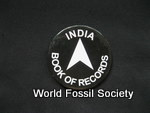A Jurassic sea monster in all its prehistoric glory has finally re-emerged into the light after 50 years cooped up in a museum storage room in Scotland. Nicknamed the Storr Lochs Monster, the newly revealed creature is actually an ichthyosaur, a kind of extinct swimming reptile that ruled the waves while the dinosaurs reigned over […]
Posts Tagged ‘Russel T Sajeev’
WFS News: Oldest fossil life found in Greenland rocks
 September 3rd, 2016
September 3rd, 2016  Riffin
Riffin @Riffin T Sajeev,Russel T sajeev The reddish peaks in this 3.7-billion-year-old rock may be structures made by microbes in a shallow ocean—if so, they would be the earliest known evidence of life on Earth.A. Nutman et. al. Nature 536, 7618 (1 September 2016) © MacMillian Publisher Ltd. Hints of oldest fossil life found in Greenland […]
WFS News: Is the anthropocene a formal unit of geologic time scale?
 August 31st, 2016
August 31st, 2016  Riffin
Riffin In the March-April issue of GSA Today, Stanley Finney (California State University at Long Beach) and Lucy Edwards (U.S. Geological Survey) tackle the hot topic of whether to define a new “Anthropocene” epoch as a formal unit of the geologic time scale. The term “Anthropocene” has receive significant coverage in both the geoscience and popular […]
WFS News: X-raying the Earth with waves from stormy weather ‘bombs’
 August 29th, 2016
August 29th, 2016  Riffin
Riffin Using a detection network based in Japan, scientists have uncovered a rare type of deep-earth tremor that they attribute to a distant North Atlantic storm called a “weather bomb.” The discovery marks the first time scientists have observed this particular tremor, known as an S wave microseism. And, as Peter Gerstoft and Peter D. Bromirski […]
WFS News: Beetles with Orchid Pollinaria in Dominican and Mexican Amber
 August 23rd, 2016
August 23rd, 2016  Riffin
Riffin @WFS News,WFS,World Fossil Society,Riffin T Sajeev,Russel T Sajeev Beetles with Orchid Pollinaria in Dominican and Mexican Amber Orchids are extraordinary plants that have evolved the strategy of dispersing their pollen in little sacs called pollinia. Pollinia are normally attached by supports (caudicles) to adhesive pads (viscidia) that stick to various body parts of the pollinator. […]
WFS News: New T Rex fossil discovered
 August 21st, 2016
August 21st, 2016  Riffin
Riffin @ WFS,T Rex,World Fossil Society,Riffin T Sajeev,Russel T sajeev A significant new Tyrannosaurus rex fossil has been unearthed by palaeontologists from the Burke Museum of Natural History and Culture and the University of Washington (UW). The find includes a nearly complete skull. Despite the fact it is one of the most iconic and well-known dinosaurs, […]
WFS News:Soot may have killed off the dinosaurs and ammonites
 August 19th, 2016
August 19th, 2016  Riffin
Riffin A new hypothesis on the extinction of dinosaurs and ammonites at the end of the Cretaceous Period has been proposed by a research team from Tohoku University and the Japan Meteorological Agency’s Meteorological Research Institute. The researchers believe that massive amounts of stratospheric soot ejected from rocks following the famous Chicxulub asteroid impact, caused global […]
WFS News: Finding Britain’s last hunter-gatherers utilising bone collagen
 August 12th, 2016
August 12th, 2016  Riffin
Riffin @ WFS ,World Fossil Society,Riffin T Sajeev,Russel T sajeev Finding Britain’s last hunter-gatherers: A new biomolecular approach to ‘unidentifiable’ bone fragments utilising bone collagen doi:10.1016/j.jas.2016.07.014 In the last decade, our knowledge of the transition from foraging, fishing, and hunting to agricultural food production has been transformed through the molecular analysis of human remains. In Britain, […]
WFS News: New light shed on how vertebrates see
 August 8th, 2016
August 8th, 2016  Riffin
Riffin The success of vertebrates is linked to the evolution of a camera-style eye and sophisticated visual system. In the absence of useful data from fossils, scenarios for evolutionary assembly of the vertebrate eye have been based necessarily on evidence from development, molecular genetics and comparative anatomy in living vertebrates. Unfortunately, steps in the transition from […]



 Posted in
Posted in  Tags:
Tags: 
